Summer’s over, semesters are starting soon for those in school, and the days still drag on for those who are slaves to the grind. Still, there are ways to keep cool and stress-free, and the best kinds involve video games! Our staff and readers are experts in Genesis therapy, and they’ve some great examples to share this month.
Grind Stormer By Ken Horowitz
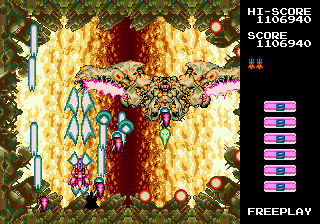 I’ve had boxed copy of this for years but never really gave it much time. I also have never had the chance to play the arcade original, so I have no frame of reference with which to gauge quality. That being said though, I find the Genesis port to be pretty intense. The alternate (V-Five) version is the one I prefer the most, but either it or the original mode offer challenging shooter gameplay in great Toaplan style. The visuals and sound are great, and there’s a definite desire to keep playing (something shooters definitely have to get right) I wasn’t aware of how expensive Grind Stormer has become, so I’m kind of thankful to have found mine when I did. It’s no Truxton, but it’s a great game nonetheless.
I’ve had boxed copy of this for years but never really gave it much time. I also have never had the chance to play the arcade original, so I have no frame of reference with which to gauge quality. That being said though, I find the Genesis port to be pretty intense. The alternate (V-Five) version is the one I prefer the most, but either it or the original mode offer challenging shooter gameplay in great Toaplan style. The visuals and sound are great, and there’s a definite desire to keep playing (something shooters definitely have to get right) I wasn’t aware of how expensive Grind Stormer has become, so I’m kind of thankful to have found mine when I did. It’s no Truxton, but it’s a great game nonetheless.
Mutant League Hockey By Sebastian Sponsel
Ever noticed how much rarer Mutant League Hockey seems to be compared to its sibling in the series, Mutant League Football? I noticed that the other day, when I was browsing through one of the only two retro gaming stores in my city. Both of them stocked MLF, boxed and with manual, and are practically giving the game away. Mutant League Hockey, on the other hand, I’ve never seen stocked in any of them. While checking my regular online retro stores, I got the same picture – complete copies of Mutant League Football are dirt cheap, while at the same time, MLH seems hardly to be found anywhere (I saw one seller on Amazon who offered a copy, but the other day it was gone again).
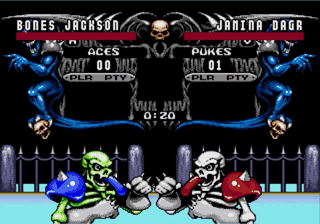 Well, I still got my copy, and since my curiosity had been piqued once more I decided to give the game another whirl. Mind you, I still like the premise of the game: undead, robots and orcs literally battling one another on the ice, with some players able to attack with weapons and environmental hazards (like landmines, sharks, or fire bombs) constantly threatening the lives of your players. Yes, MLH has a rather unique approach to the genre. Bribe the referee so that he calls more penalties against your opponent. If too many of your players have been booked, stage a jailbreak and rush the ice. Or flat-out kill the referee and mash your opponents into a pulp (literally) so they have to forfeit their game, even if they were leading in goals. Makes for some interesting plays, that’s for sure.
Well, I still got my copy, and since my curiosity had been piqued once more I decided to give the game another whirl. Mind you, I still like the premise of the game: undead, robots and orcs literally battling one another on the ice, with some players able to attack with weapons and environmental hazards (like landmines, sharks, or fire bombs) constantly threatening the lives of your players. Yes, MLH has a rather unique approach to the genre. Bribe the referee so that he calls more penalties against your opponent. If too many of your players have been booked, stage a jailbreak and rush the ice. Or flat-out kill the referee and mash your opponents into a pulp (literally) so they have to forfeit their game, even if they were leading in goals. Makes for some interesting plays, that’s for sure.
I remember enjoying the game a lot in the old days, and it could still be loads of fun – if it just weren’t so damn choppy and slow. The players control like… well, hunks of dead flesh on ice, really. I guess that’s appropriate in a way. But considering that EA, the company that published the game, was able to produce the rather excellent NHL games at the same time really makes you wonder. NHLPA ’93 plays way smoother and better than MLH does, that’s for sure. On the other hand, Mutant League allows you to gang up with your entire team, rush the goal and literally kill the opposite goalie, or shoot across the ice with rocket-propelled pucks. Well, can’t have everything, I guess. Would make the NHL a way more interesting place, that’s for sure…
Sonic CD By Joseph C.
I recently grabbed the Xbox Live re-release of Sonic CD. I have played through the game before so this was just an impulse buy for a price that I don’t believe anyone could complain about. Sonic CD used to be wrapped in mystery as the one Sonic game I could not play. I had rarely even seen it available in stores, and the one time I did see it bundled with a Mega CD and one other game, I, to my eternal regret, passed it over for the just-released Sonic 3D Blast. When I finally did play it, I was a little underwhelmed. This was possibly due to a mix of expectations, time and the fact that it was the PC version.
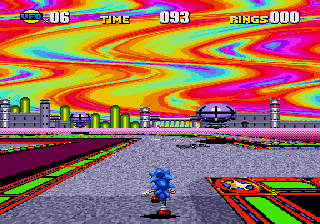 The first thing I have to talk about is the soundtrack. As stated, I first played Sonic CD on PC which I believe had the American soundtrack and later played the PAL version which had the original Japanese soundtrack. I honestly cannot decide which one I prefer and it made even starting the XBLA version (which includes both) very difficult. If could end the argument, it could only be by saying, “Come on! They are both great!” but I somehow guess that this is a regular attempt to end an endless argument.
The first thing I have to talk about is the soundtrack. As stated, I first played Sonic CD on PC which I believe had the American soundtrack and later played the PAL version which had the original Japanese soundtrack. I honestly cannot decide which one I prefer and it made even starting the XBLA version (which includes both) very difficult. If could end the argument, it could only be by saying, “Come on! They are both great!” but I somehow guess that this is a regular attempt to end an endless argument.
Next up would be the gameplay. As someone who only owned a Mega Drive and who played the Sonic games completely out of order of release, I have always found Sonic CD a strange game. It looks like Sonic 1 but has the spindash; but the spindash doesn’t look like the Sonic 2 spindash. It also has the time travel mechanic which feels completely out of place but very innovative at the same time. I can hardly criticize any of this given the order in which I played the games, but it has always felt like a strange game to me. That said Sonic CD is still fun and fast and a lot better than any post-’90s efforts but I still think I want to like this more than I actually do.
Magic Girl By Greg Jurkiewicz
This past month I’ve been mostly playing the Sega Saturn as I’ve recently purchased one and developed a certain fondness for this blocky black sheep of a system. However, I haven’t completely neglected the Genesis. I picked up a copy of Magic Girl a while ago and it finally arrived last week. It’s another one of those obscure Chinese pirate games made by Gamtec. Gamtec is pretty hit and miss when it comes to their games, at their best they’ve done stuff like Squirrel King and Tiny Toon Adventures 3, and at their worst they’ve done stuff like well… Magic Girl.
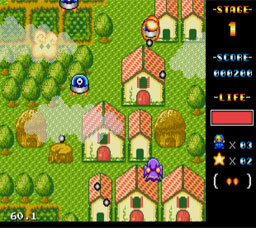 Let me explain though. This game isn’t necessarily terrible; it’s just mind-bendingly bizarre-looking. On the surface it’s a simple shooter where you play as a little cartoon witch and fly around on a broom stick blasting things with magic beams. However the selection of things you’re killing is just surreal, it really looks like something out of a Salvador Dali nightmare. The enemies range from flying eyeballs, to flying antlers with eyeballs, to airborne snakes to random geometric shapes that are out to get you. The bosses are even more peculiar ie: the giant clam-something boss from the first level. The power-up system is equally weird – every once in a while this demented looking yellow cloud thing floats on the screen and gets in between your bullets and some of the enemies, you shoot the bloody thing a bunch of times and it eventually goes away and a power-up appears. I never actually figured out the specifics of how this works, ie: if it depends on how many times you shoot the bastard or what, but if that thing is supposed to be a helper it sure does a good job of helping the enemies when it’s around.
Let me explain though. This game isn’t necessarily terrible; it’s just mind-bendingly bizarre-looking. On the surface it’s a simple shooter where you play as a little cartoon witch and fly around on a broom stick blasting things with magic beams. However the selection of things you’re killing is just surreal, it really looks like something out of a Salvador Dali nightmare. The enemies range from flying eyeballs, to flying antlers with eyeballs, to airborne snakes to random geometric shapes that are out to get you. The bosses are even more peculiar ie: the giant clam-something boss from the first level. The power-up system is equally weird – every once in a while this demented looking yellow cloud thing floats on the screen and gets in between your bullets and some of the enemies, you shoot the bloody thing a bunch of times and it eventually goes away and a power-up appears. I never actually figured out the specifics of how this works, ie: if it depends on how many times you shoot the bastard or what, but if that thing is supposed to be a helper it sure does a good job of helping the enemies when it’s around.
Now if all that isn’t enough to make this game feel like a whacked out LSD trip, the music and constant PEW PEW PEW of your attack don’t help either. The music is very abrasive and repeats often, and your attack sounds are just a little too loud. So not only do you end up looking at something that looks like a hallucinogen induced delusion, if you play with the sound on you end up listening to something that sounds like drug distorted techno music. This game is just insane. I still had a good time playing it, but I don’t think this game is for everyone… kinda like dropping a lot of acid and listening to techno music…
Altered Beast By Goldenband
I didn’t grow up with the Genesis, but thanks to a late 1980s magazine article about the upcoming 16-bit systems from NEC and Sega, I certainly knew about Altered Beast back in the day. The screenshots were more than impressive to my teenaged self, with huge sprites that far exceeded what was possible on the NES or my home computer.
Even so, I didn’t get a copy until a couple years ago. By then I was aware of the game’s dual identity, so to speak, in the Genesis library: on the one hand, it’s a beloved launch title that seems to have lots of nostalgia value for many people; on the other it’s one of the console’s most frequently mocked games, derided for its absurd sound samples and bizarre, almost Tom of Finland-esque design style.
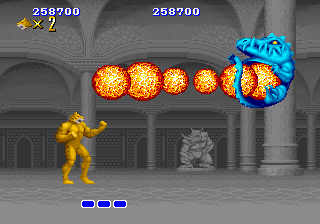 So how does Altered Beast hold up for someone coming to it with fresh eyes? Well, I’ll admit I was initially put off by the quirky hit detection, somewhat stiff controls, and unforgiving difficulty. With no health refills of any kind, every single hit counts against you, and there’s no way to make up for your mistakes. When I first sat down and made a serious attempt to figure Altered Beast out, the frustration ultimately got the better of me, and I ended up shelving it for a couple years.
So how does Altered Beast hold up for someone coming to it with fresh eyes? Well, I’ll admit I was initially put off by the quirky hit detection, somewhat stiff controls, and unforgiving difficulty. With no health refills of any kind, every single hit counts against you, and there’s no way to make up for your mistakes. When I first sat down and made a serious attempt to figure Altered Beast out, the frustration ultimately got the better of me, and I ended up shelving it for a couple years.
I picked the game back up this month, however, and ended up beating it several times, working my way up to the hardest settings. In the process of doing so, I gradually decided that there was a lot to like about Altered Beast. In truth, it’s basically a memorization game in which you need to anticipate what’s coming next…and once you accept that and come to grips with each level, it starts becoming more fun. In other words, it’s satisfying to master Altered Beast — something that assuredly isn’t true of every game I’ve beaten on the Genesis.
And of course, the game itself is total camp, though it’s unclear how much of that is intentional and how much is just the reflection of a more innocent time. Either way, the imagery of Altered Beast is hilarious, outrageous, and often beggars belief, and that adds a lot to the fun factor. (My favorite is the power-up stage right before the character transforms, when he becomes a tiny little head atop a ridiculously muscular body.)
It’s a pity, though, that the ending sequence isn’t the same as the arcade version, in which (I’m told) the entire cast is revealed to be a bunch of costumed actors who hoist huge beers in a final toast to the player. Instead the Genesis got a fairly lame, by-the-numbers credit sequence that barely qualifies as “forgettable”.
All things considered, Altered Beast is a little bit like a tuba. It’s big and goofy, tends to attract attention, and if you play it enough to get good at it, it’s actually pretty fun. And if you don’t play it at all, no one will really mind if you make fun of it, since after all it’s pretty ridiculous. But playing it just a little bit probably won’t lead to anything good.
Grind Stormer By The Coop
I’m something of a shmup nut. I greatly enjoy the genre, and I’ve got a fair number of the ones that came out on the Genesis/Mega Drive over the years. Some are good (Thunder Force 4, M.U.S.H.A., Steel Empire, etc.), some are bad (XDR, The Earth Defend, Master of Weapon, etc.), but overall, I’ve gotten at least a little enjoyment from them all to some degree; even if it was just laughing at how sloppily it was programmed. But there’s one shmup that I picked up from a Blockbuster long ago, that I’ve never really given much thought about. It was always just kind of… there, on my Genesis games shelf. Then a few weeks ago, I was playing in a shmup competition, where V-Five (the alternate version of the game I’m speaking of, Grind Stormer) came up for play, and it made me revisit this little forgotten game in my collection.
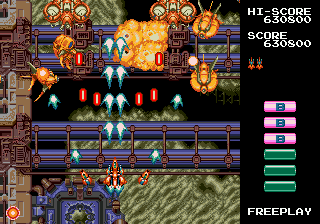 For those not in the know, Grind Stormer on the Genesis has two modes. The first, is called Grind Stormer, where you pick up power-up items that are automatically applied right away. This will change your weapon to whatever you picked up, and you increase its strength by picking up the same weapon icon several times in a row. The second mode is called V-Five, and this one features a more Gradius-like power up system, in that you pick up little gems until you reach the power-up you want on the list, and then select it by pressing a button on the controller. You can then increase its strength by selecting “Power” when you get enough gems. It’s still the same bosses, stages and everything, it’s just how you power up that’s altered. The other main difference here, in that you don’t have to avoid both power-up items, and bullets/enemies in V-Five, as you won’t lose your weapon of choice by picking up a gem. Plus, you can get bonuses at the end of each stage in V-Five if you get all of the gems, helping to boost your score.
For those not in the know, Grind Stormer on the Genesis has two modes. The first, is called Grind Stormer, where you pick up power-up items that are automatically applied right away. This will change your weapon to whatever you picked up, and you increase its strength by picking up the same weapon icon several times in a row. The second mode is called V-Five, and this one features a more Gradius-like power up system, in that you pick up little gems until you reach the power-up you want on the list, and then select it by pressing a button on the controller. You can then increase its strength by selecting “Power” when you get enough gems. It’s still the same bosses, stages and everything, it’s just how you power up that’s altered. The other main difference here, in that you don’t have to avoid both power-up items, and bullets/enemies in V-Five, as you won’t lose your weapon of choice by picking up a gem. Plus, you can get bonuses at the end of each stage in V-Five if you get all of the gems, helping to boost your score.
Anyway, getting back to the shmup tournament, I played through the arcade ROM in MAME, and did all right in terms of the standings. But what I also did was get a better appreciation for the Genesis port of the game. I’d never played the arcade game before, and both seeing and hearing it made me realize that the makers behind the Genesis port actually did a pretty good job with it. The visuals and gameplay are pretty close, and with both gameplay modes in there, you basically got a solid port of one of the last shmups Toaplan made. It’s not arcade perfect obviously, as the Genesis version suffers from bullet count changes, color loss, music instrument changes, and things like that. It’s toned down and simplified a bit to be sure. But, it’s solid port which now seems to go for some rather crazy money at times.
So yeah, if you can find a working copy of the game (some of Tengen’s Genesis carts don’t always live that long), it’s not a bad shmup. It didn’t get much in the way of a big advertising push or anything, as it came out after the shmup deluge on the Genesis had died off. But it’s a solid 16-bit port of a decent arcade game that not many likely got the chance to play.
Mossae’s Quest (mini-game of Pier Solar) By Frank Villone
This month, I dusted off Pier Solar for the first time in ages. I had taken a long break, after finishing a section that I was stuck on for quite a while. My old game file resumed at the castle that Mossae had flown my characters to, over the pink ocean. Soon, Mossae’s Quest was unlocked! The dragon flies high above a colorful landscape, which passes hundreds of feet below, with smooth Mode 7-style scaling.
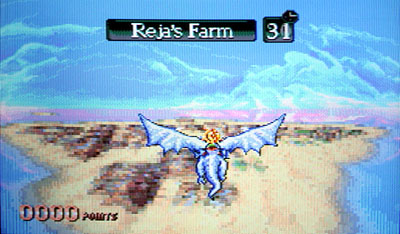 It is a rare sight on the Genesis, which lacks hardware support for this effect! The Super Nintendo was released two years after the Genesis, of course, and it was heavily emphasized that it had extra hardware dedicated for Mode 7, used in titles like F-Zero. However, the Genesis needs only some skilled programming to pull off the same effect, running in software only! WaterMelon proves it, with great style.
It is a rare sight on the Genesis, which lacks hardware support for this effect! The Super Nintendo was released two years after the Genesis, of course, and it was heavily emphasized that it had extra hardware dedicated for Mode 7, used in titles like F-Zero. However, the Genesis needs only some skilled programming to pull off the same effect, running in software only! WaterMelon proves it, with great style.
Mossae soars toward blue mountains on the horizon, over scaling islands of green and yellow, and blue water with pink reflections! “Dreaming” plays, a beautiful song on cartridge, and the CD version is heavenly! Parts of it sound like a chorus of angels singing. Just press left and right, to steer the flight freely in all directions. The goal is to find the locations that are named on-screen; Flying over each one earns a point, a speed boost, and extended playtime.
It is a blast to play a few short games in a row, and it delivers the visual over-stimulation that we all crave from the Genesis! Mossae’s Quest is just one more reason that everyone needs a copy of Pier Solar!

Recent Comments